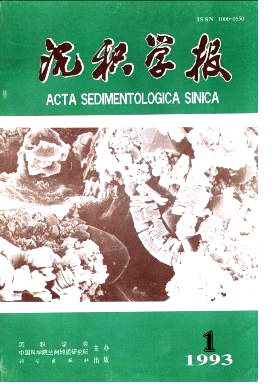Diagenesis and Porosity Evolution of Carbonate Rocks in the Lower Triassic Qinglong Formation, Southern Jiangsu Province, China
- Received Date: 1991-01-11
- Publish Date: 1993-03-10
Abstract: Diagenesis in the lower Triassic Qinglong formation of Southern Jiangsu are very complex and can be divived into nine kinds: micritization, deep- water cementation in the sea floor, shallow-water comentation, dolomitization, compaction and pressolution, dissolution, neomorphism, pyritization and silicification, structural fissure. Among those, micritization often formed micrite envelope on grain surface in shallow-water areas, which can prevent early-stage dissolution and protect casting pores formed by the dissolution. Deep-water submarine cementation occurred in the slope-basin areas and generally formed nodules or hard ground during no sedimentation. Shallow-water cementation can be clearly distinguished into three periods: 1 .Forming of fibrous, dog-toothed, or foliaceous cements, which reduced 5-10% of original pores; 2.Forming of equigranular cements decresed about 20-30% original pores; 3.The Forming of grain mosaic-like sparry cements, which were clearly uncomformable with the first and the second cements and reduced pores about 5%. Four kinds of the dolomitization are recognised: 1.Dolomites formed by penecontemporaneous dolomitization are usually intergrowthed with gypsum; 2.Mixed water dolomitization occured in the shallow- water areas, its result are euhedral to hemieuhedral dolomite rhombsthat distribute in dissolved pores of intraclast ooide coments, or matrix of lime wackestone and packstone; 3.Dolomites caused by deeply buried pressolution occurred in microstylolitic groups and clay bands or nearby stylolites; 4.Epigenetic dolomitization controlled by the structure commonly distribute along faults and the contact of dolomite surface with wall rocks is transitional or abrupt. Compaction and pressolution ordinaryly made rock porosity reduce greatly, but accompanying pressolved dolomilization and late dissolution, porosity and permeability could be increased. There are mainly three periods of dissolution in the areas discussed, the first occurred in platform shoal beach facies and created a lot of dissolved pores in the intergrains and intragrains; the second formed in buried diagenetic stages and were effective reservior spaces for the most part and were frequently filled with oil, gas and asphalt; the third dissolution happened in supergene stages and was majorly on recent or ancient erosional surfaces. Crystal Overgrowth that caused by neomorphism generally reduce a great deal of pores. The silicification was formed in supergene stages and occurred universally, especially in the slope-basin facies. Besides the increasing of porosity, more importantly, structural fissures raised permeability. Studying results showed: orginal pores influenced by the diagenesis changed greatly, in the shallow-water areas rapid drop of original pores was principally influenced by the cementation, but in the deep-water slope and basin the decrease of pores was chiefly affected by the compaction and pressolution. Besides, according to test data two potential reservior rocks in carbonate rocks of Qinglong formation are discoverd: one is lime grainstone of shoal beach facies in southeast districts and its porosity is 0.27 to 4.30% and permeability is 0.01 to 0.51 × 10-3μm2; another is nodular limestone and calcirudites of slope-basin facies in the western district and its porrosity is 1.31 to 1.98% and permeability 0.41 to 0.53 × 10-3μm2.
| Citation: | Jiang Yuehua, Yue Wenzhe, Ye Zhizheng, Wei Naiyi. Diagenesis and Porosity Evolution of Carbonate Rocks in the Lower Triassic Qinglong Formation, Southern Jiangsu Province, China[J]. Acta Sedimentologica Sinica, 1993, 11(1): 47-55. |






 DownLoad:
DownLoad: